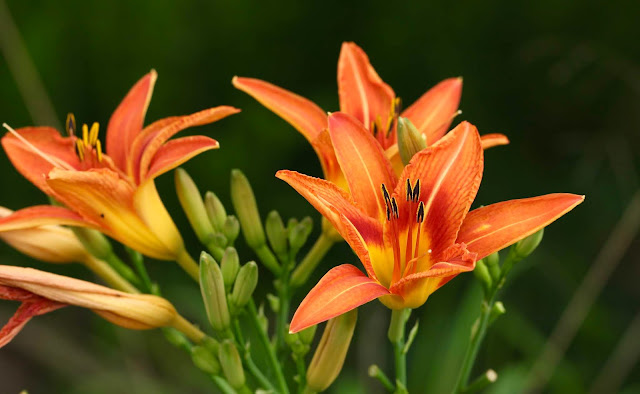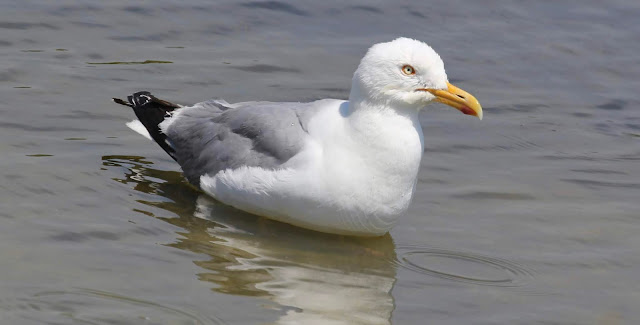The
Edwin B. Forsythe
National Wildlife Refuge is
located within Atlantic and Ocean Counties along the southern New Jersey coast.
Approximately, 47,000 acres
of salt marsh (80%), shallow bay, tidal flats, dunes, and pine forest are protected and managed by the U.S. Fish and Wildlife Service. These coastal habitats
are especially crucial for birds that use the Atlantic flyway for fall and
spring migration. There are also several threatened and endangered species that
call the refuge home. Most of the refuge is relatively inaccessible to the
general public. But, in Oceanville (800 Great Creek Rd., Oceanville,
NJ 08205) there is a visitor center, an
eight-mile wildlife drive, and 3.7 miles
of trails that allows visitors to view the incredible flora and fauna protected
in this reserve.
 |
| Refuge marker along the 8-mile wildlife drive. |
 | |
|
FLORA
At
the beginning and end of the 8-mile
wildlife drive there is typical maritime forest habitat. Typical trees include
a mix of hardwoods such as Sassafras (Sassafras albidum), Red Maple (Acer rubrum), various oaks
trees including Southern Red Oak (Quercus
falcata), Post Oak (Q. stellata),
and Black Oak (Q. velutina). Assorted gymnosperms include Red Cedar (Juniperus virginiana) and Pitch Pine (Pinus rigida). Shrub layers and understory
include
Sweet Pepper Bush (Clethra alnifolia), Wax Myrtle (Morella
cerifera), Bayberry (M. pensylvanica), Arrowwood Viburnum ( Viburnum
dentatum) and Beach Plum (Prunus maritima). Vines include Virginia Creeper
(Parthenocissus quinquefolia), Catbrier (Smilax rotundifolia),
and Poison Ivy (Toxicodendron radicans).
Within the wetlands, fresh and brackish waters, you typically see a mix
of Narrow Leaved Cattail (Typhya angustifolia), various
Spartina species such as Spartina patens, Salt
Marsh Bulrush (Schoenoplectus
maritimus), Spikegrass (Distichlis
spicata), Marsh Elder (Iva frutescens), Marsh Mallow (Althaea officinalis), Groundsel Bush (Baccharis halmifolia), and the invasive
Common Reed (Phragmites australis). Of course, there are many other species through-out
the refuge too numerous to mention!
 |
| Narrow Leaved Cattail (Typhya angustifolia), note the male flowers at the top of the spike and female flowers at the bottom. |
 |
| Moth Mullein (Verbascum blattaria), flowers may be white or yellow. |
 |
| Blanket-flower (Gaillardia pulchella) |
 |
| Non-native but naturalized Day Lilies ( Hemerocallis fulva) growing along roadsides near the refuge. |
 |
| Purple Coneflower (Echinacea purpurea) |
 |
| Bindweed (Calystegia sepium) This is from an October trip. Fruits of the invasive Oriental Bittersweet (Celastrus orbiculatus). |
BIRDS
The
refuge protects and provides nesting sites for the federally threatened Piping
Plover and other special species such as Black Skimmers, Least Terns, and
American Oystercatchers. I did see Black Skimmers and American Oystercatchers
along the drive. I really enjoyed watching the Black Skimmers gracefully “skimming”
along the canals. Although I did not visit the refuge during the peak of spring
or fall migration, I did manage to view a total of 55 bird species, about half
of which were various waterfowl and shore birds. For most people, including
myself, the Ospreys stole the show! Numerous nesting platforms are spaced out
along the length of the 8-mile wildlife drive and every platform supported an
Osprey family. The chicks were large and kept the parents busy bringing fish to
the nest. It was awesome to watch the adults shred the fish and feed the young!
One sad note, many of the Osprey nests had plastic shopping bags incorporated
into the nest structure.
 |
| Barn Swallow, these birds were common at the begining of the 8-mile wildlife drive near the visitor center. They were nesting under the boardwalks. |
 |
| Herring Gull adult, notice the red dot on the bottom of the lower bill. |
 |
| ? Common Tern or Forster's Tern, they are very difficult to tell apart. I asked two other birders and got two different answers. |
 |
| Great Egret feeding in the marsh. Purple Martin at visitor center. Blue Grosbeak |
 |
| Snowy Egret feeding, if you look closely you can see the yellow feet. |
 |
| Red-winged Blackbird, probably the most common bird in the refuge! |
Unfortunately,
I just missed a rare visit by a Roseate Spoonbill (only the 5th or
6th time reported for the state), but a fellow birder did give me a tip about a
nearby Tricolored Heron that is also an unusual visitor to N.J.
Canada Goose, head is 'muddy' from feeding.
MAMMALS
I was amazed and pleasantly surprised by the
diversity of mammals I observed within a relatively short time and small area. While driving along the 8-mile loop
and exploring several of the shorter trails I observed White-tailed Deer (Odocoileus virginianus), several
Muskrats (Ondatra
zibethicus), Gray Squirrels (Sciurus carolinensis), an Eastern
Chipmunk (Tamias striatus), a
Raccoon (Procyon lotor), and a River
Otter, (Lutra canadensis). I observed
one Muskrat cutting aquatic vegetation (sedges) and swimming with the plants
towards the canal bank and out of my sight. Another Muskrat was feeding. It did
not seem bothered by my presence and sat for quite a while eating vegetation.
The highlight of one day was seeing a River Otter! It was swimming among the
water lilies at the end of Gull Pond Road. I was so excited that I forgot to
snap a picture before it dived back under the water and disappeared. This area
is where I also saw the Raccoon. It was at the water’s edge and I think we
surprised each other. The Raccoon quickly retreated into the thick brush. It
was probably looking for turtle nests to raid. I had seen evidence all day of destroyed
turtle nests. It was obvious that the eggs had not hatched naturally, the
shells were usually some distance from the nest cavity and arranged in small
piles. On another trip to the refuge a mink (Neovison vison) the road in front of my car.
 |
| Muskrat (Ondatra zibethicus), this muskrat was busy feeding on vegetation in a canal parallel to the wildlife drive. |
 |
| Eastern Chipmunk (Tamias striatus ) |
REPTILES AND AMPHIBIANS
Often
when I am hiking I will snap photos of plants and animals with the idea that I
will make a more positive identification later. So, I was pleasantly surprised
when looking at my photos that a toad I had seen along Jen’s Trail turned out
to be a Fowler's Toad (Bufo woodhousii fowleri) a N.J. species of special
concern. It is often confused with the more common Eastern American Toad (Bufo
americanus). One way to separate the two species is to look at the back of the
head. On Fowler’s Toads the parotid glands touch the postorbital ridge while on
the Eastern American Toad there is a gap or small connecting spur between the
parotid glands and postorbital ridge.
 |
| Fowler's Toad (Bufo woodhousii fowleri) a N.J. species of special concern! |
The
Northern Diamondback Terrapin (Malaclemys terrapin) is
the only turtle species, in the world, that inhabits brackish water for their
entire life. On my first day visiting the refuge the turtles were everywhere!
The females were in the forests, along the canals banks, in the roads, and even
crossing bridges looking for suitable nesting sites. There was easily 100+
turtles sighted along the wildlife drive through the refuge. Cars were stopping
and waiting for turtles to cross or carefully driving around them.
Unfortunately, many of the females were
trying to dig nests and lay eggs directly in the gravelly roadbed. Many moved
once cars approached and I hope they found safer more suitable nest locations.
There was also much evidence that many of the nests had fell victim to raccoons
and other predators. The “Conserve Wildlife Foundation of N.J.” stated that, “ Only around 1-3% of the
eggs laid actually produce a hatchling, and success rates of young reaching
adulthood is also low.” The exact population status of the Northern Diamondback
Terrapin in N.J. is not known. Other nearby states such as Rhode Island and Massachusetts have the turtles listed as endangered or threatened respectively.
Many N.J. conservation groups are supporting studies and lobbying for more
protection of this unique species. Oddly,
on my other two visits on subsequent days I probably saw less than 10 Terrapins
total!
 |
| Female Northern Diamondback Terrapin (Malaclemys terrapin) looking for a suitable nesting site. |
 |
| Northern Diamondback Terrapin (Malaclemys terrapin) |
 |
| Northern Diamondback Terrapin (Malaclemys terrapin) |
Two other turtle species seen within the
refuge was the Eastern Mud Turtle (Kinosternon
subrubrum) and Common Box Turtle (Terrapene
carolina).
INSECTS
I
did not focus on insects, but several species were very conspicuous along the
wildlife drive and trails in the refuge. One notorious species was the
Greenhead Horsefly (Tabanas nigrovitatus).
They are actually pretty flies with large emerald green eyes and yellowish
bodies, but the females feed on blood, including human blood, and can deliver a
painful bite. Simply opening your car door allows dozens to quickly enter and
fly around the interior, annoying you even within the supposed protection of
your car. As I drove around the refuge I was constantly lowering the windows
enticing them to fly back out. What was really intimidating was the huge clouds
of Greenheads that would follow the car even as you were driving! At one point,
Alfred Hitchcock’s “ The Birds” came to
mind as I tried to avoid the biting swarms. I did spray with OFF insect
repellant which helped some but, over
the years Greenheads have become fairly resistant to many commercial bug sprays
and even with protection you still receive numerous bites. So, as I stood with
my binoculars and camera I alternated between nature watching and swatting
flies. I also suddenly understood the large occurrence of
Purple Martin houses in yards and around parks in Southern N.J.
 |
| Greenhead Horsefly (Tabanas nigrovitatus) |
The
other insect was much more passive and beautiful, this was the Monarch Butterfly (Danaus plexippus). Large populations of Common Milkweed (Asclepias syriaca),
Butterfly Weed (Asclepias tuberosa), and other wildflowers grew along
the wildlife drive providing food and shelter for the Monarchs and many other butterflies
and insects.
 |
| Monarch Butterfly (Danaus plexippus)on Butterfly Weed (Asclepias tuberosa). |
A side view of a Monarch on a purple coneflower.
 |
| Halloween Pennant (Celithemis eponia) |
The
Edwin B. Forsyth Wildlife Refuge is definitely on my list of favorite wildlife
viewing areas. For four dollars a day (per car) the 8-mile wildlife loop is the
biggest bang for your buck!
RESOURCES:
GENERAL
REFUGE WEBSITE: https://www.fws.gov/refuge/Edwin_B_Forsythe/
REFUGE
BROCHURE: https://www.fws.gov/uploadedFiles/Region_5/NWRS/North_Zone/Edwin_B_Forsythe/ForsytheBrochure.pdf
REFUGE BIRD
LIST: https://www.fws.gov/uploadedFiles/Region_5/NWRS/North_Zone/Edwin_B_Forsythe/ForsytheBirdList.pdf












